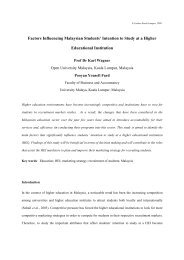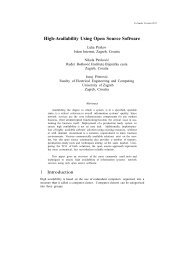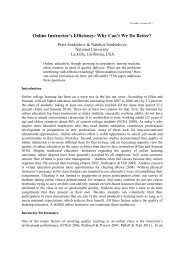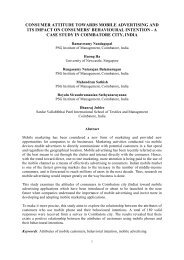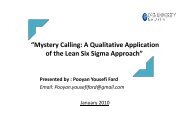download pdf - CASA
download pdf - CASA
download pdf - CASA
Create successful ePaper yourself
Turn your PDF publications into a flip-book with our unique Google optimized e-Paper software.
Presented to E-Leader Conference-Ho Chi Minh City, Viet<br />
Nam, January 3-5, 2011<br />
by Clifford Tyler, Ed. D.<br />
National University<br />
Department of Educational Administration<br />
National University School of Education<br />
San Jose, California, USA<br />
and<br />
Gloria Loventhal, MA<br />
Leadership Connection<br />
San Jose, California, USA
Abstract<br />
This paper will examine the applications of Howard Gardner’s Multiple<br />
Intelligences (MI) theory to differential instructional strategies for the<br />
education of adults in institutions of higher education (IHE).<br />
With more IHE classes being offered online, there are new challenges and<br />
opportunities for individualizing instruction to meet unique student needs to<br />
assure their success.<br />
MI holds great promise in differentiating instruction for online classes by<br />
applying these intelligences to online instruction.<br />
This paper will define Multiple Intelligences (MI) theory, provide background<br />
information about IHE online instruction, assessment of students, how they<br />
can identify their MI strengths, and how online course activities can be applied<br />
to MI Theory.<br />
The role and training needs for instructors in utilizing MI Theory will also be<br />
discussed, along with the challenges for instructors to make a paradigm shift<br />
applying and practicing MI to meet the individual needs of all students in<br />
online courses.
Agenda<br />
Definitions of Multiple Intelligence<br />
Identifying primary and secondary<br />
intelligence<br />
Examples of Different Multiple Intelligences<br />
Role of Professors in Utilizing Multiple<br />
Intelligences in Online Instruction<br />
o Applying Multiple Intelligences in Designing<br />
Class Strategies and Activities<br />
o Involving Students By Identifying Their Learning<br />
Styles for Multiple Intelligences<br />
o Application of Multiple Intelligences To Online<br />
Instruction<br />
o Conclusion
Tenants of Multiple Intelligences: Each person<br />
possesses all eight intelligences between the lowest<br />
and highest extreme.<br />
1.) Linguistic Intelligence:<br />
The capacity to use words effectively, whether<br />
orally (e.g., as a storyteller, orator, or politician)<br />
or in writing (e.g., as a poet, playwright, editor,<br />
or journalist).<br />
These learners have well developed auditory skills and<br />
are generally elegant speakers. There thought process<br />
is in words as opposed to pictures.
2. Logical-Mathematical Intelligence:<br />
The capacity to use numbers effectively (e.g., as a<br />
mathematician, tax accountant, or statistician) and to<br />
reason well (e.g., as a scientist, computer programmer, or<br />
logician).<br />
These learners think conceptually in logical and<br />
numerical patterns making connections between pieces<br />
of information.<br />
Always curious about the world around them, the learner<br />
asks lots of questions and like to do experiments.<br />
(ldpride.net)
3. Spatial Intelligence:<br />
The ability to perceive the visual-spatial world accurately<br />
(e.g., as a hunter, scout, or guide) and to perform<br />
transformations upon those perceptions (e.g., as an interior<br />
decorator, architect, artist, or inventor)<br />
4. Bodily-Kinesthetic Intelligence:<br />
Expertise in using one's whole body to express<br />
ideas and feelings (e.g., as an actor, a mime, an<br />
athlete, or a dancer) and facility in using one's<br />
hands to produce or transform things (e.g., as a<br />
craftsperson, sculptor, mechanic, or surgeon).
5. Musical Intelligence:<br />
The capacity to perceive (e.g., as a music aficionado),<br />
discriminate (e.g., as a music critic), transform (e.g., as a<br />
composer), and express (e.g., as a performer) musical forms.<br />
6. Interpersonal Intelligence:<br />
The ability to perceive and make distinctions in the moods,<br />
intentions, motivations, and feelings of other people.<br />
Learners try to see things from other people's point of view<br />
in order to understand how they think and feel. They have<br />
the skill to sense feelings, intentions and motivations.<br />
Although manipulative at times, they are great organizers.<br />
They make an effort to reach groups consensus and encourage<br />
co-operation.<br />
Both verbal (e.g. speaking) and non-verbal language (e.g. eye<br />
contact, body language) are used to open communication<br />
channels with others. (ldpride.net)
7. Intra-personal Intelligence:<br />
Self-knowledge and the ability to act adaptively on the<br />
basis of that knowledge.<br />
These learners seek their dreams, relationships, inner feelings,<br />
relationships with others strengths and weaknesses.<br />
Some of their skills include: reflecting and analyzing<br />
themselves, being aware of their inner feelings, analyzing their<br />
desires and dreams, evaluating their thinking patterns,<br />
reasoning with themselves, understanding their role in<br />
relationship to others. (lpride.net)<br />
8. Naturalistic Intelligence:<br />
The ability to easily recognize and classify plants, animals, and<br />
other things in nature. (Armstrong, 1994).<br />
Naturalistic Intelligence was later added after Gardner’s<br />
original seven intelligences.
Activity: Group Splits Into Pairs or Three’s<br />
Pairs to identify their Multiple Intelligence strengths<br />
and favorite activities to support that strength.<br />
Complete Personal Inventory of Intelligence, Score,<br />
and Interpret
Examples of Multiple Intelligences<br />
The most brilliant scientific professor may well have exceptional<br />
intelligence in a number of areas (probably Logical-<br />
Mathematical, and one or two others) but will also be less able in<br />
other intelligences, and could well be inept in some.<br />
A person who struggles with language and numbers might easily<br />
be an excellent sportsman, or musician, or artist.<br />
A hopeless academic, who is tone-deaf and can't add up, could<br />
easily possess remarkable interpersonal skills.<br />
Many very successful business-people judged failures at school.<br />
They were judged according to a very narrow definition of what<br />
constitutes intelligence.
Examples of Different Multiple Intelligences<br />
Many successful and fulfilled people in life were also<br />
judged to be failures at school - brilliant scientists, leaders,<br />
writers, entertainers, sports-people, soldiers,<br />
humanitarians, healers, religious and political leaders<br />
Each one of us has a unique and different mix of<br />
intelligence types, and commonly the people with the least<br />
'conventional' intelligence (as measured using oldfashioned<br />
narrow criteria), actually possess enormous<br />
talent - often under-valued, unknown and underdeveloped.<br />
(Businessballs.com)
Role of Professors in Utilizing Multiple Intelligences in<br />
Online Instruction<br />
Research confirms that the instructors’ most important role is to<br />
motivate students: moving from being an intellect on-stage<br />
performer to a learning catalyst on-line.<br />
This is accomplished through both an asynchronous virtual<br />
community between students and their instructors. (Yi,<br />
Cornelious, 2004), and a synchronous “class live pro,”<br />
Although some (usually full-time) skillful instructors will have<br />
an innate ability to motivate students on-line, most need<br />
comprehensive training to make it happen.
Role of Professors in Utilizing Multiple Intelligences in<br />
Online Instruction<br />
Frequency of interaction and prompt responses to all students is<br />
another key to successful on-line instruction for all multiple<br />
intelligence activities.<br />
Studies have shown that the single greatest factor affecting student<br />
satisfaction in distance education course is the amount of interaction<br />
that occurs between teacher and students.<br />
This happens from the instructor’s careful planning of collaborative<br />
course activities (Kirby, Elizabeth, 1999). This study is confirmed by<br />
some instructors making some fatal mistakes by not introducing<br />
themselves on-line at the beginning of the course, or immediately<br />
before the course begins.<br />
Others do not respond to individual student threaded discussion<br />
responses (instead respond to a group of student responses), or delay<br />
their response for two or three days.
Connecting Higher Education Online Instruction and<br />
Teaching Strategies with Multiple Intelligences<br />
When curriculum, instruction, assessment, and pedagogy are<br />
viewed through a Multiple Intelligence (MI)<br />
perspective, there are a myriad of ways for student to learn.<br />
Some online courses offer more options for students to<br />
learn utilizing a variety of Multiple Intelligences than other<br />
courses.<br />
When MI is the palate, the instructor (professor) relies on<br />
her/his wisdom to find the right brush and the right colors to<br />
make learning meaningful. (Hoer, 2002).<br />
In order to locate the right brush, students should be encouraged<br />
to take a “learning styles self-assessment .”
Applying Multiple Intelligences in Designing Class<br />
Strategies and Activities<br />
Number of teaching materials and methods available in MI<br />
beyond the traditional professor as lecturer mode.<br />
Three specific Multiple Intelligences will be selected applicable<br />
for Educational Administration online classes.<br />
1.)Linguistic Intelligence, which is typically strong<br />
in reading books and literature, communication<br />
skills, and writing skills.<br />
Class activities that promote these skills may include<br />
large and small group discussions, brainstorming in<br />
class live pro, chat-room, and threaded discussions<br />
among faculty and students and between students.<br />
Writing and interactive activities are also alternative<br />
activities.
Applying Multiple Intelligences in Designing Class<br />
Strategies and Activities<br />
2.) Spatial multiple intelligence also lends itself to the Action<br />
Research online class as students prepare their action research<br />
paper, because of its emphasis on visualizations, i.e. charts,<br />
graphs, diagrams and maps.<br />
These are typically found in the appendices of the paper. Bar and<br />
line graphs along with pie charts are used for student<br />
performance comparisons and pre and post test scores.<br />
3.) Inter-personal and intra-personal Multiple Intelligences also<br />
provide exciting possibilities for online classes. Extensively<br />
applied as students are encouraged to work together in<br />
cooperative groups where interpersonal interaction is practiced.<br />
Collaboration among peers, peer feedback and tutoring,<br />
students presenting to the class in class live pro, and<br />
encouragement of group editing are also effective activities.
Involving Students By Identifying Their Learning Styles<br />
for Multiple Intelligences<br />
Learning styles are different from Multiple Intelligences, in that<br />
learning styles are different approaches to learning.<br />
Examples: visual (learn through seeing)<br />
auditory (learn (learn through moving,<br />
through listening)<br />
tactile/kinesthetic doing, touching).<br />
According to Gardner, each child and adult possesses and can<br />
develop all seven intelligences to a fairly high level of<br />
competence, although children and adults show an inclination,<br />
i.e. proclivities.<br />
Information about learning styles and Multiple Intelligence (MI)<br />
is helpful for everyone especially for people with learning<br />
disabilities and Attention Deficit Disorder (ldpride.net).
Application of Multiple Intelligences To Online<br />
Instruction<br />
Online instruction is gaining in popularity in both higher<br />
education and virtual high schools because of the access<br />
convenience to students, compared to on-site classes.<br />
How much will instructors utilize Multiple Intelligences in<br />
delivering online instruction that meets every student need and<br />
capitalizes on their strengths<br />
Instructor utilization will depend on both the higher education<br />
institution and instructor commitment to utilizing Multiple<br />
Intelligences theory for online class instruction.<br />
Offers students a greater chance for success than utilizing a<br />
single measure of intelligent quotient (IQ) or student test taking<br />
skills.
Delivery of Multiple Intelligence Instruction<br />
How will instructors deliver Multiple Intelligences<br />
instruction to 25 or more students for an online course in a<br />
previously packaged and prepared course shell curriculum?<br />
It should start with instructors surveying student multiple<br />
intelligence by administering a Multiple Intelligences test<br />
Following an assessment of student Multiple Intelligences<br />
strengths and weaknesses, students should be given a<br />
choice of course activities that matches their strengths.<br />
For example, students who have a strength in Linguistic<br />
multiple intelligence should appropriately be assigned a<br />
written research report for the class capstone assignment.
Assessing Student Performance<br />
How will instructors assess individual student<br />
performance, using different Multiple Intelligences, when<br />
it comes to posting their course grade?<br />
Instructors will assess student performance by the agreed<br />
on assessment activities<br />
Based on the student multiple intelligence strength(s).<br />
Examples may include essay midterm and/or final exam(s),<br />
student research project, oral presentation on class live pro,<br />
etc.
Traditional vs. Multiple Intelligence Role of<br />
Instructors<br />
One significant feature of MI is that it transforms the role of the<br />
teacher.<br />
In traditional courses, teachers typically rely on – are often tied to –<br />
text books and other mandated curriculum materials.<br />
The name of the game is often scoring well on standardized tests.<br />
Naturally, then, materials are purchased which prepare students for the<br />
tests; the closer the match between the curriculum and what is tested,<br />
the "better" the curriculum.<br />
Aside from the losses to students – which are considerable – this<br />
approach also takes a heavy toll on teachers.<br />
How much fun can it be to read from a script all day? What's the<br />
message to us about our competencies when everything is set out and<br />
predetermined by a faraway publisher? (www.newhorizons.org › ... ›
Training of Instructors to Deliver Differentiated<br />
Online Instruction<br />
How will instructors be sufficiently trained to provide<br />
differentiated instruction online to meet multiple student<br />
needs?<br />
The sufficiency of training depends largely on the<br />
institution of higher education (IHE) commitment, and<br />
enlisting only the instructors genuinely interested and<br />
committed to online instruction.<br />
Training may include familiarity with Multiple Intelligence<br />
theory, differentiated instruction, and assessment of<br />
student performance in each course.<br />
Instructors not interested nor confident in their ability to<br />
teach online classes should never by coerced by IHE’s into<br />
teaching online classes.
Conclusion<br />
The future use of Multiple Intelligences to higher<br />
education online instruction holds much promise because<br />
it provides a legitimate form of differentiated instruction to<br />
meet the individual needs of adults to assure their success<br />
for online courses.<br />
Furthermore, it provides alternative means for instructor<br />
assessment of student performance based on the strengths<br />
of students rather than relying on a traditional IQ.<br />
However its utilization success for differentiated<br />
instruction will depend on the level of commitment and<br />
training by instructors to implement Multiple<br />
Intelligences.
References<br />
Armstrong, Thomas, Multiple Intelligences in the Classroom, Alexandria, Virginia: ASCD<br />
(1994).<br />
www.Businessballs.com<br />
Cooper, L. On-line courses tips for making them work. Technological Horizons in<br />
Education Journal, 27<br />
(8), 87-92 (2000)<br />
Gardner, Howard. Frames of Mind, Basic Books (2006.<br />
Hoerr, Thomas, Applying MI in Schools. NewHorizonsForLearning.org. January 2002<br />
http://www.ldpride.net<br />
www.newhorizons.org › ... › multiple intelligences).<br />
http://www.spannj.org/BasicRights/appendix_b.htm)<br />
TeacherVision.com. “Multiple Intelligences: An Overview-The Eight Intelligences<br />
Described.”


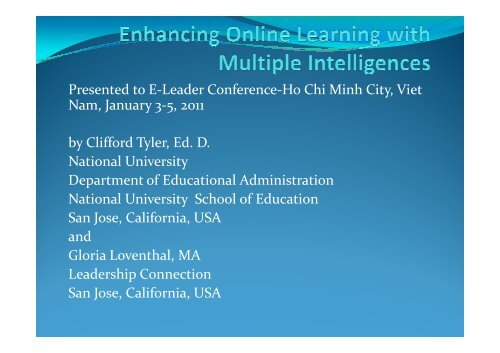
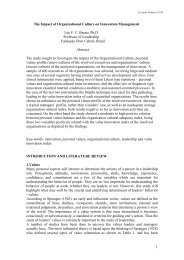
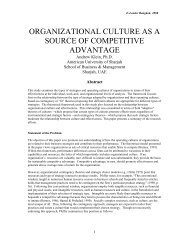
![Oberholzer [Compatibility Mode].pdf - CASA](https://img.yumpu.com/21081507/1/190x135/oberholzer-compatibility-modepdf-casa.jpg?quality=85)


